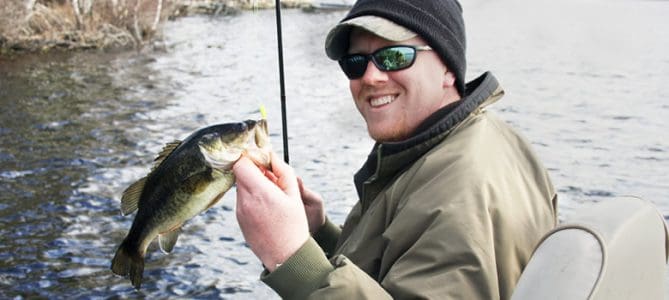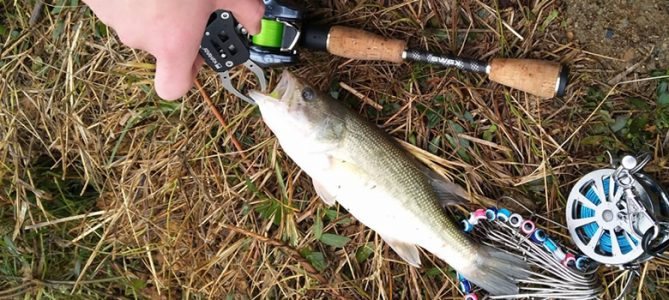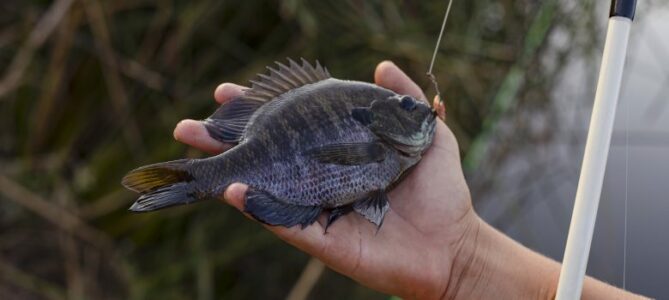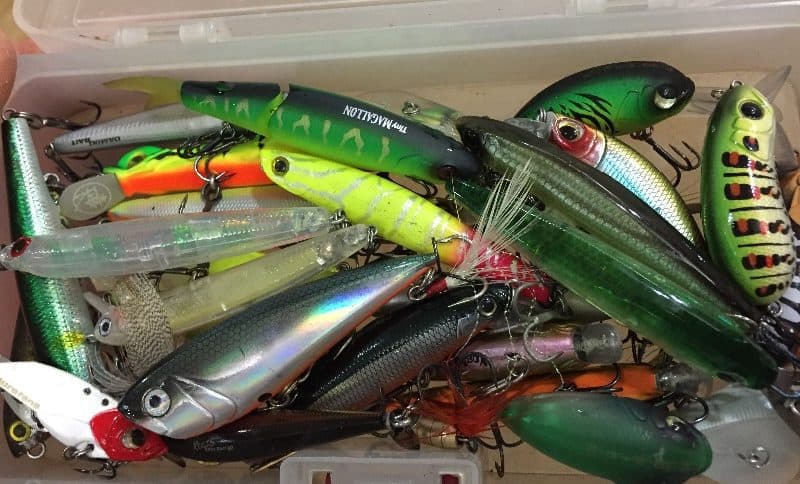If you buy via a link on this page, we may receive a commission, at no extra cost to you.Learn more
Crappie fishing is exciting. The feeling of hitting a school of crappie when they are in a feeding frenzy is an adrenaline rush. What makes Crappie fishing different is that the bag limits are typically larger, Crappies are plentiful and their meat is sweet, flaky, and amazing. Read on to learn how to catch these beauties without a fish finder!
Is it possible to have this experience when you don’t have a fish finder? Yes. Before the invention of the fish finder, people had been successfully catching crappie for generations. In this article, I explain 5 top tips to locate crappie and have a productive day fishing crappie without a fish finder.
Five areas to ensure success when fishing for crappie without a fish finder:
- Local Knowledge
- Crappie Psychology
- Location
- Reading The Lake
- Drifting
Local Knowledge
Before you go out on the water searching for crappie, it pays dividends to do your homework. Yes, homework is not my favorite part of fishing either. When the result is a productive day of crappie fishing it is definitely worth the effort.
Importance Of Doing Homework
Plan and research your chosen body of water to the best of your ability. Search local fishing Facebook groups, online fishing articles, and sport fishing magazines.
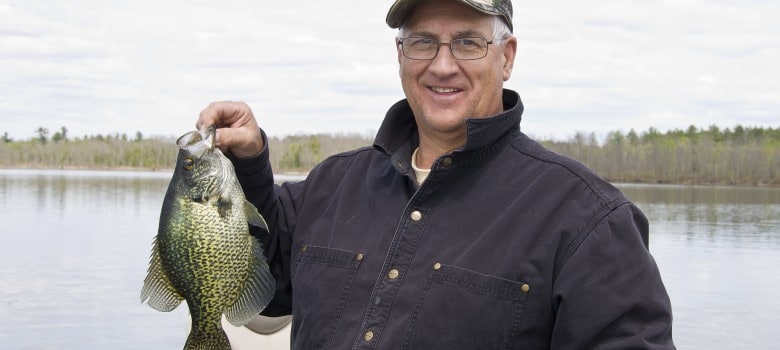
After finding a lake that sounds promising for crappie, make sure the information is up to date. It would be disappointing to plan a trip to a crappie “hotspot” to find that it has been overfished or polluted. Take the time to gather local knowledge.
Gathering Local Knowledge
Engage people and ask questions. No fisherman is going to give up their personal honey hole. They will likely boast about catching 50 crappies in two hours though if given the chance. Visit local bait and tackle shops and coax out nuggets of valuable information. What is the crappie biting on? What lake is producing now? Who’s catching what and where?
ALSO READ: BEST FISHING RODS FOR CRAPPIE
Engaging With Local Fishermen
It does not matter if the lake is 100 miles away and you have never been there. Having researched the lake, the crappie should be there. When you visit, try to strike up a conversation with local fishermen. They hold a wealth of knowledge that can help you. What next? This is where psychology comes into play.
Understanding Crappie Psychology
Back to the books! It is important to understand your target species, crappie. By understanding how they live and behave our chances of catching them increase. What do crappie eat? When do they eat? Where do crappie eat? Crappie are school fish. Where there is one- there are many. We need to understand where the crappie congregates in large numbers to feed.
Factors To Consider
Seasons and weather affect the behavior of crappie. In the summer large crappie will be close to the shore and hugging structures, seeking shade. As the weather gets colder the crappie will move to deeper water. When it starts to turn cold stay close to your known hotspots. Now, go further out into the deeper water casting ever deeper until you find them. Remember all your potential crappie haunts and try the deeper spots. Although they may not have been produced in the summer heat it is quite possible that they are now the new hotspots.
Location
Like in real estate, location is important. After having chosen a lake, and studied crappie behavior – it’s time to hit the water!
Reading The Lake
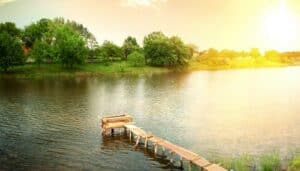
Look for weed beds on the body of water you are fishing. These can change throughout seasons. Find the edge of the weed bed, where the weeds stop in the water, and cast as close to the edge as possible. Crappie will often lie in the weeds and strike at passing baitfish.
Scan the lake looking for visible structures. This would include fallen trees or half-submerged boats. Crappie love to hang out in shady protected areas. This is why it’s important to be able to read the environment and recognize where the potential crappie hotspots are located.
ALSO READ: BEST FISHING REELS FOR CRAPPIE
Drifting
You tried your best to think like crappie and predict where they will be. If you haven’t found the crappie yet, our next course of action is to drift. Stay close to the bank, some ten to twenty yards offshore. Take note of any obstacles such as rocks, weeds, and docks. You will want to bypass them all but keep as close to the edge of the obstacle as it is safe to do.
Pick a point where you will start the drift and where you will finish. The longer the drift the better as you will cover more potential spots in a faster time.
At the starting point turn the boat sideways with the bow toward shore. Keep the wind in your favor to start the drift. If you hit crappie, great. Take note of where you caught the fish but continue the drift. If you finish the drift without another hit, start the drift again. If on this drift you hit crappie at about the same point, then you have found them.
Finish the drift again and if there are no more hits return to where the crappie hit and anchor up. There are times crappie will savage a drifting bait but have no interest in a static bait- it all depends on their mood. Be versatile, be willing to adapt, and try to understand why the crappie prefers drifting bait. Either way, you have achieved your goal and found crappie.
Using A Contour Fishing Map
Taking the time to study the contour map is time well spent. An excellent tool to understand where the crappie will be is a good contour fishing map. The map will show what is happening under the water. Where the structures, bridges, rocks, and shoals are. Maps are available online, in a library or you can buy fishing maps at local tackle stores.
Understanding Crappie Behavior
Crappie use vision and smell to detect prey. Their eyes are among the largest for freshwater fish of their size. Crappie will often close in on their prey for closer inspection. They can also quickly snap at bait and release it just as quickly if they find it to be objectionable. By understanding how crappie behave we increase our odds of success.
Crappie As A school Fish
Crappie move around in large schools. This is one of the reasons crappie fishing can be exhilarating because when you catch one crappie you are likely to catch many. They are particularly prone to schooling together during the pre-spawning period and post-spawning period-mid-March to mid-May depending on the water temperature. The ideal water temperature for crappie spawning is 61-68 degrees Fahrenheit.
Seeking Underwater Structures With Shade And Food
Look for underwater structures that give shade to the fish and the prey they feed on. Crappie love this kind of environment. When rocks are visible jutting from the open water then there are likely shoals and drop-off points. Perfect for crappie if you stay within a 12-foot range. If you decide to check these out, approach them with caution. It is advisable to have a buddy at the bow to slowly guide you in. There won’t be shade but if you can see an overhang in the water- fish it. A map will not show you overhanging trees, but this could be a promising spot. Know where the sun will rise. If it’s behind the trees, there will be shade and crappie lurking below to catch any fallen insects.
Inlets As Potential Hotspots
Are there any inlets of water feeding the lake or river system? An inlet feeds the main body of water and carries crustaceans, minnows, and other food sources to wait for fish. In heavy water, fish lay close to inlets where lots of goodies are sure to be flowing in. If there is no shade at the inlet, pick your time of day to fish. Dawn, dusk, or nighttime. The water around inlets is usually the first area to warm in the spring. Don’t worry if the water appears muddy. If the water is warm, the crappie will come.
Time Of Day To Target Crappie
Crappie like most fish or game animals feed in the morning, before sunrise, and up to two hours after sunrise. They are also very active up to two hours before sunset. Crappie are most active in low-light conditions. Once you are familiar with a lake consider nighttime fishing. But you already know that, right? Because you have done your research before you started to fish.
Conclusion
In this article, we have discussed how to find crappie without electronic equipment. Preparation and research are the keys to your success, especially without a fish finder. We gain invaluable insight through local knowledge, using contour fishing maps and being able to read bodies of water for potential crappie hotspots. We now know that by understanding how crappie behaves we are going to increase our chances of catching them.
The best crappie fishing I ever had was many years ago with my wife’s Grandfather, fishing on Georgian Bay in Ontario. My wife’s Grandfather did not have a fish finder. He did have a wealth of local knowledge and understood the behavior of crappie. He could read the lake and its conditions. It was a fantastic evening of crappie fishing.
There is a wealth of information on crappie on the internet. Study it all to improve your knowledge. Is it possible to find crappie without a fish finder? The answer is yes. I know from experience. And that’s not a fisherman’s tale. Happy fishing.

